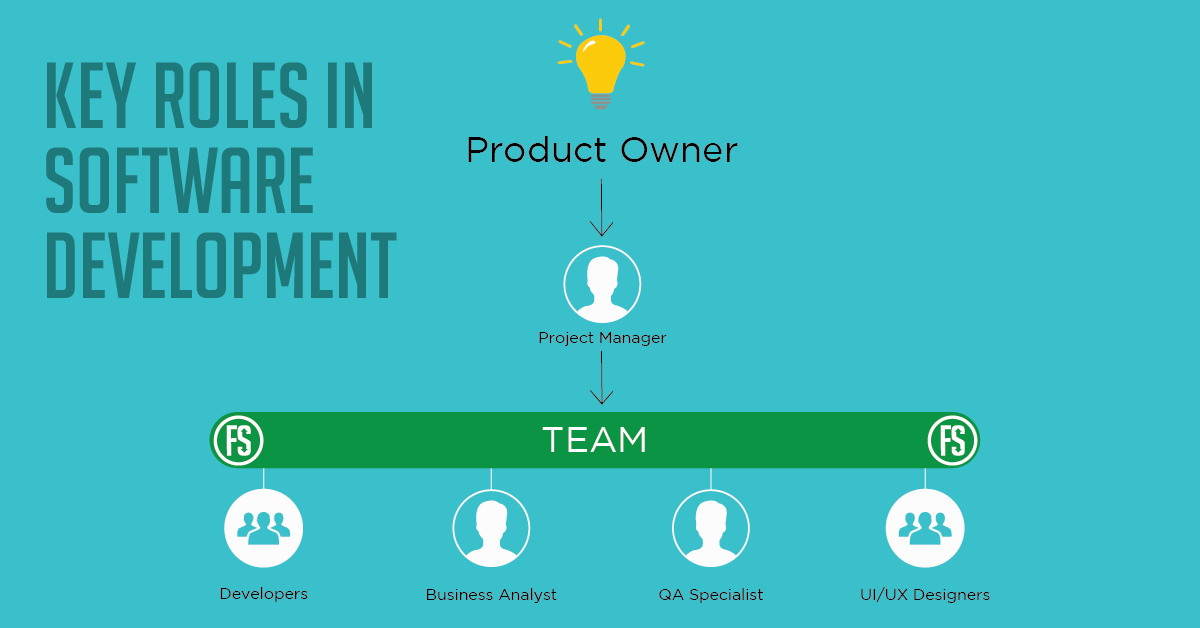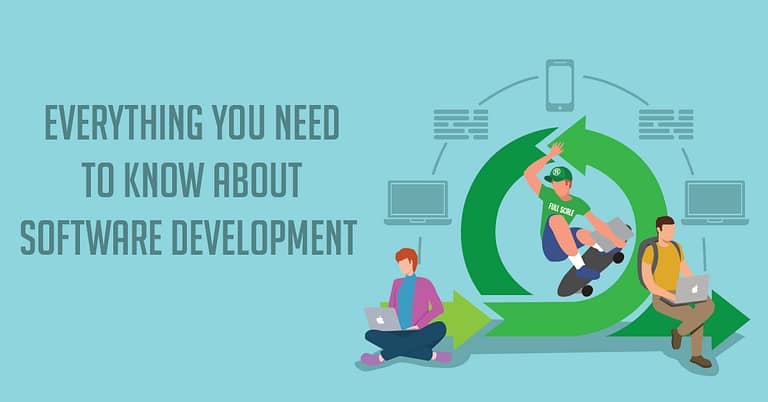Last Updated on 2025-05-30
Building your own software? Dig into everything you need to know about software development—quite possibly the most booming industry in today’s business world.
In this digital era, most solutions to a problem come as software. When you look around, you see all different kinds of it—web and mobile applications, Software-as-a-Service, middleware, and system software, among others. These products are all a result of software development.
Most people imagine software development as a group doing magic in a lab to build one product. And that is not far from the truth. With constant divination of what the clients want or the lines of text not understandable to a normal person, magic looks like a mild day in software development.
But comparisons aside, software development is the most disruptive solution for multiple global businesses and industries. In this article, we’ll delve into everything you need to know about software development. Here are our key discussions:
- How Does Software Development Work?
- Know More About Software Development Teams
- Best Practices in Software Development
- Hire a Software Development Team
How Does Software Development Work?
IBM defines software development as “a set of computer science activities dedicated to the process of creating, designing, deploying and supporting software.” These activities have subsets that converge to realize a full-fledged software product. We have the team assembly part, product development, and the actual groundwork of writing code.
Let’s look at the different phases of the software development lifecycle (SDLC). The SDLC defines the fundamental steps a software product undertakes to complete a defined iteration or version. It usually starts by building a minimum viable product (MVP) and then moving forward to build enhancements, fixes, and new features.
So, let’s discuss each essential phase of software development.
1. Research and Validation
The first phase involves how the team conceives the software product in the abstract. The team answers questions like “how did the product come to mind?” or “what problem does it solve?” In this case, they will refine all the software application ideas into one solid solution.
Then, the team can perform product research and market validation. This is the phase that aims to hit the following objectives:
- Is there a problem that the product solves?
- Does a market for this product exist?
- Are there similar products in the market?
- Does this product have a competitive advantage?
- Define the short-term and long-term goals of the product.
2. Design
In the design phase, subject matter experts collaborate to architect the entire system. The team works together to create a product requirements document (PRD) that encompasses the entire software’s functional and non-functional requirements. This technical document also defines the scope and limitations of the software product to build the MVP.
Moreover, the user interface and user experience designers work directly with decision-makers to map out the software’s behavior. Software engineers and architects define the technologies used to build the software product.
3. Development
For this phase, the software developers begin writing code for the software. Each program they build will be tested and validated alongside the requirements. Regularly, the team will sync up to discuss the accomplishments, current tasks, and blockers while doing the project.
4. Testing
The testing stage expands the testing efforts on the software to ensure that each bit cross-checks the requirements indicated in the PRD. There are various types of testing, mainly functional and non-functional testing—both manual and automated.
Here are the types of functional testing:
- Unit testing
- System testing
- Integration testing
- User Acceptance testing
These are the types of non-functional testing:
- Performance testing
- Security testing
- Compatibility testing
- Usability testing
Note that there are other types of software testing depending on the needs of the system.
5. Deployment and Maintenance
Once the software undergoes development and testing, it’s time to release it. The deployment environment would depend on the type of software—web application, desktop application, mobile application, cloud service, etc.
The final product may exhibit some issues, so it is imperative that the team continuously monitors the software’s status. Furthermore, this is the time to gather customer feedback and conduct studies to integrate new features, enhancements, and fixes. The system development lifecycle will then continue.
Read: Agile vs. Waterfall
Know More About Software Development Teams
So, we’ve learned about the processes that go into software development. These processes are essential to ensure that the team successfully takes the product to market; it takes skilled team members that know and understand their specific role(s) in project completion.

This part will introduce the key roles and positions in software development. Let’s start.
Product Owner
As a primary software project stakeholder, a product owner oversees the product’s vision. They mostly work with the clients to identify, assess, and refine the product requirements. As such, their main responsibility is to supervise the team and ensure that the project navigates toward the target direction.
Project Manager
The project manager has a more hands-on role in software development than the product owner. They are responsible for breaking down tasks and delegating them to the appropriate team members. Moreover, they facilitate communication within teams and track project milestones and timelines.
Get a project manager if you need someone to keep your project in check! That’s what we recommend to all our clients here at Full Scale. And it works!
Developers
Software developers come in different types depending on expertise. First, we have front-end developers skilled in building the user-facing side of the software. Second, we have back-end developers who program the server-side of the system. They write the software’s responses based on users’ inputs.
Finally, we have full-stack developers capable of doing both front-end and back-end development. Meaning, they’re experts in building both ends of the software from scratch.
UI/UX Designers
The User Interface and User Experience designer roles encompass the work related to the software’s look and feel. They create how the software looks visually and how elements of the pages interact and respond. Some designers only specialize in either UI or UX. But it’s also cost-effective to hire a designer who can wear both hats.
The UI/UX Designer and the Front-end Developer when they meet in person. pic.twitter.com/nzBJ1FrxKw
— Oladimeji Abubakar (@oladimejiuiux) July 4, 2022
QA Testers
The quality assurance (QA) team ensures the software performs as intended. They also identify problems in the development of the actual product.
In addition, they perform tests at any point in development and as needed. For example, when a developer finishes a task, they can pass it on to a QA resource for testing.
Business Analyst
A business analyst handles the business aspect of building the technology. This means that they perform research and analysis on the current market trends and behavior to identify how the software fits in. In a smaller team, the roles of the business analyst and product owner can sometimes merge for one person.
Best Practices in Software Development
We’ve already identified the “what” and the “who’s” of software development. It’s time to answer how to ensure success in this endeavor. Here’s a list of the common best practices in software development that are relevant in today’s tech landscape.
1. Foster open lines of communication
Open communication builds a solid foundation for a software team. As an industry that relies on trust and transparency, it pays to establish a space where everyone can express their thoughts freely.
Whether it’s on task breakdown, workflows, or feedback, each member must be empowered to speak up and be heard. This is also a great way to show that each part of the team not only has contributions but valuable ones.
2. Build comprehensive process documentation structures
One thing that disrupts a project’s progress is the lack of documentation. It should be mandatory to document every part of the project from start to finish. The team can work on creating a product requirements document and keep tabs on their own activities.
Some essential information to include:
- coding standards
- time spent on tasks
- tools used
- access credentials
- daily or weekly milestones
- code reviews
- code versions
- release versions
- release notes
3. Use the right tools
A well-organized team and workflow aren’t enough to ensure software development success. Using the right tools maximizes the capabilities of the things your team can do and improve the overall productivity.
At Full Scale, our developers are well-versed in choosing the right tools for development. We also train our developers to be flexible, so there is a shorter learning curve when using new tools or frameworks.
4. Lead strategically
A strong leadership strategy generates a more effective team collaboration. Leaders should promote an environment where developers are encouraged to experiment. In this way, the team can feel more creative in approaching each task and developing innovative solutions.
Hire a Software Development Team Today!
Full Scale knows everything about software development. As such, we have assembled software development teams for our growing clientele.
We specialize in providing fast and affordable offshore software development services without breaking the bank. Our offshore arm in the Philippines is a hub of talented, globally-competitive software experts.
Our talent pool is all you need to form a software development team! We also have project managers, QA specialists, designers, and digital marketing experts alongside software developers.
Build Your Software Team Today

Matt Watson is a serial tech entrepreneur who has started four companies and had a nine-figure exit. He was the founder and CTO of VinSolutions, the #1 CRM software used in today’s automotive industry. He has over twenty years of experience working as a tech CTO and building cutting-edge SaaS solutions.
As the CEO of Full Scale, he has helped over 100 tech companies build their software services and development teams. Full Scale specializes in helping tech companies grow by augmenting their in-house teams with software development talent from the Philippines.
Matt hosts Startup Hustle, a top podcast about entrepreneurship with over 6 million downloads. He has a wealth of knowledge about startups and business from his personal experience and from interviewing hundreds of other entrepreneurs.





